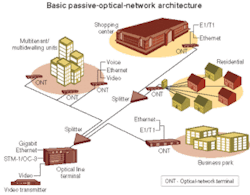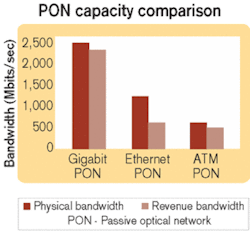Gigabit PONs are not just for Ethernet services
There has been much buzz of late about passive-optical-network (PON) technology. The Joint Procurement Contract (JPC) among BellSouth, SBC, and Verizon for fiber to the premises (FTTP) late last year focused on PON technology, and that has caused many carriers to revisit their thinking on PON as a viable access technology.
Yet, much like the early days of xDSL—with CAP, DMT, IDSL, ADSL, HDSL, and other variants causing inertia and confusion in the industry—there is considerable confusion and debate over the primordial access soup of PON. ATM PON (APON) and its sister broadband PON (BPON), Ethernet PON (EPON), and gigabit PON (GPON) comprise the current ingredients of this soup.
Among these ingredients, GPON is often confused as being suitable only for provisioning Ethernet and Gigabit Ethernet services. Yet GPON is a practical answer for voice, video, and data services deployment. More important, GPON is a standard that supports both legacy traffic in its native format and the evolution to an all-packet/all-IP network of the future with unprecedented economics.
To begin, it is important to place PON technology in the network. PONs are used as an access technology linking the central office (CO) or headend to the customer premises or cabinet for fiber to the home (FTTH), business (FTTB), or curb (FTTC) applications. PONs are generally not used for metro or long-haul applications.PON technology allows the service provider to share the fiber cost of running fiber from the CO to the premises among many users—usually up to 32 locations. As shown in Figure 1, the fiber run from the CO is brought to a centralized distribution point, then fiber laterals extend from this fiber to each customer location. The extension of the fiber is done via passive optic splitters or filters at the distribution point, which guide the laser light on the fiber to their appropriate locations.
PONs do not require any power requirements in the outside plant to power the filters or splitters, thereby lowering the overall operational cost and complexity. And because the single fiber either in a ring or tree technology is shared, this "high-cost" capital deployment of fiber for several kilometers is lower than if the carrier were to deploy individual fibers to each location.
PON technology is nothing new. The original PON standards focused on ATM as a Layer 2 protocol solution, evolving from work initiated at British Telecom. The standards were formalized in the Full Services Access Network (FSAN) consortium (www.fsanweb.org) and, eventually, in the International Telecommunications Union's ITU-T as the G.983.x specification. This work, now commonly known as APON or BPON, supports the majority of the early deployments around the world and is the basis for the JPC. The three RBOCs in the JPC chose APON/BPON for initial deployments.
Yet APON/BPONs may have difficulty scaling to meet the bandwidth requirements of these carriers—and others—as they begin to deploy more Ethernet and switched Ethernet services for the delivery of high-speed data and switched digital video. For example, APON/BPONs generally scale to 622 Mbits/sec downstream (CO to customer premises) and 155 Mbits/sec upstream (the reverse direction), and with ATM protocol overheads subtracted, generally support up to 448 Mbits/sec of usable/saleable bandwidth in the downstream direction. With bandwidth requirements per subscriber increasing in the years ahead, that is a major stumbling block for APON/BPON deployment and greatly limits the number of users that can be served per PON. One of the main benefits of PON is being able to share the costs of the long-haul trunk(s) from the CO to the premises. If the return on investment for these trunks is constrained by the amount of bandwidth available per subscriber, the overall business case for PON is lost.
For that reason, work began with the FSAN consortium and ITU several years ago around a new PON standard that would be able to meet these burgeoning bandwidth and service requirements. The resultant standard is now known as GPON and is a fully ratified ITU-T standard known as G.984.x.
GPON supports two methods of encapsulation: the ATM and GPON encapsulation method (GEM). The ATM method is an evolution of existing APON/BPON standards, and all voice, video, and data traffic is encapsulated at the customer premises for transport back to the CO. With GEM, all traffic is mapped across the GPON network using a variant of SONET/SDH generic framing procedure (GFP). GEM supports a native transport of voice, video, and data without an added ATM or IP encapsulation layer.
The results of using GPON with GEM are a dramatic increase in bandwidth utilization. GPONs support downstream rates as high as 2.5 Gbits/sec and upstream rates from 155 Mbits/sec to 2.5 Gbits/sec—a significant increase over standard APON/BPON.
GPON also affords a dramatic increase in usable bandwidth per user when compared with EPON. In addition to support of up to 2.5 Gbits/sec per PON, the use of GEM means that only 4%–5% of this bandwidth must be set aside for overhead, leaving the rest for revenue. Per the latest work in the IEEE, EPONs support up to 1.25 Gbits/sec but give up as much as 50% of that due to protocol overheads, leaving only 600 Mbits/sec (approximately) for revenue use.Figure 2 highlights the saleable/revenue bandwidth per PON technology versus the physical, or line-speed, bandwidth for each of the three approaches. As shown, GPON represents the best revenue bandwidth of all PON technologies. Given that traditional equipment and outside plant technologies do not change much per version of PON supported, the case for GPON is very strong.
These bandwidth/ROI arguments make GPON a very compelling business case for today's carriers. With GPON:
- The ROI on network deployment is greatly enhanced versus APON/BPON and EPON, where for similar capital outlay, a smaller number of users can be supported given the overall bandwidth afforded with each network protocol.
- There is a graceful migration plan from legacy T1/E1 voice circuits to an all-IP network. GPON fully supports all Ethernet signaling required for quality of service (QoS), class of service, and other advanced features, while also supporting the traditional mapping of voice trunks via SONET/SDH signaling via GEM. This migration plan is unique to GPON and allows the carriers to make a decision about when to migrate their trunks to voice over IP.
- GPON fully supports the triple play of voice, video, and data services. With GEM, traffic is carried in its native format without the burden and costs of additional protocols. With APON/BPON, all services must be mapped over an ATM layer. With EPON, all services must be mapped over Ethernet/IP. In comparison, GPON offers savings in bandwidth overhead for encapsulation and guarantees end-to-end clocking and QoS.
GPONs are ideally suited for carrying both the emerging Ethernet/IP traffic of today and tomorrow, while also mapping legacy voice and video services onto the PON using a variant of SONET/SDH GFP protocol, which fully supports end-to-end clocking and other plesiochronous services. With GPON, for the first time, PONs can evolve from carrying today's legacy TDM services to an all-IP/packet-based network in the future and supply up to 2.5 Gbits/sec of shared bandwidth in the process.
GPONs are ideally suited for FTTX deployments, whatever the architecture. From the same trunk from the CO, services for FTTH, FTTC, and FTTB are possible, all carrying voice, video, and data. With some implementations of this GPON network, the network can also be fully redundant either in a ring or tree architecture. With the use of CWDM, multiple GPONs can be carried over the same fiber, thereby increasing the ROI per capital expenditure on fiber deployment.
Of all the PON technologies being deployed by carries around the world, only GPON delivers on the original promise of PON—cost savings for service deployment in the access network, especially against the backdrop of support for the emerging Ethernet/packet services. For those customers located 5, 10, 20, or 30 km from the metro ring, GPON represents a tremendous opportunity for affordable broadband access that cannot be met with competing standard copper, xDSL, or PON technology.
Gary Lee is chief executive of FlexLight Networks (Kennesaw, GA—www.flexlight-networks.com) and chairman of the PON Forum (www.ponforum.org), an organization of passive-optical-network vendors focused on the business and marketing aspects of the PON industry.


